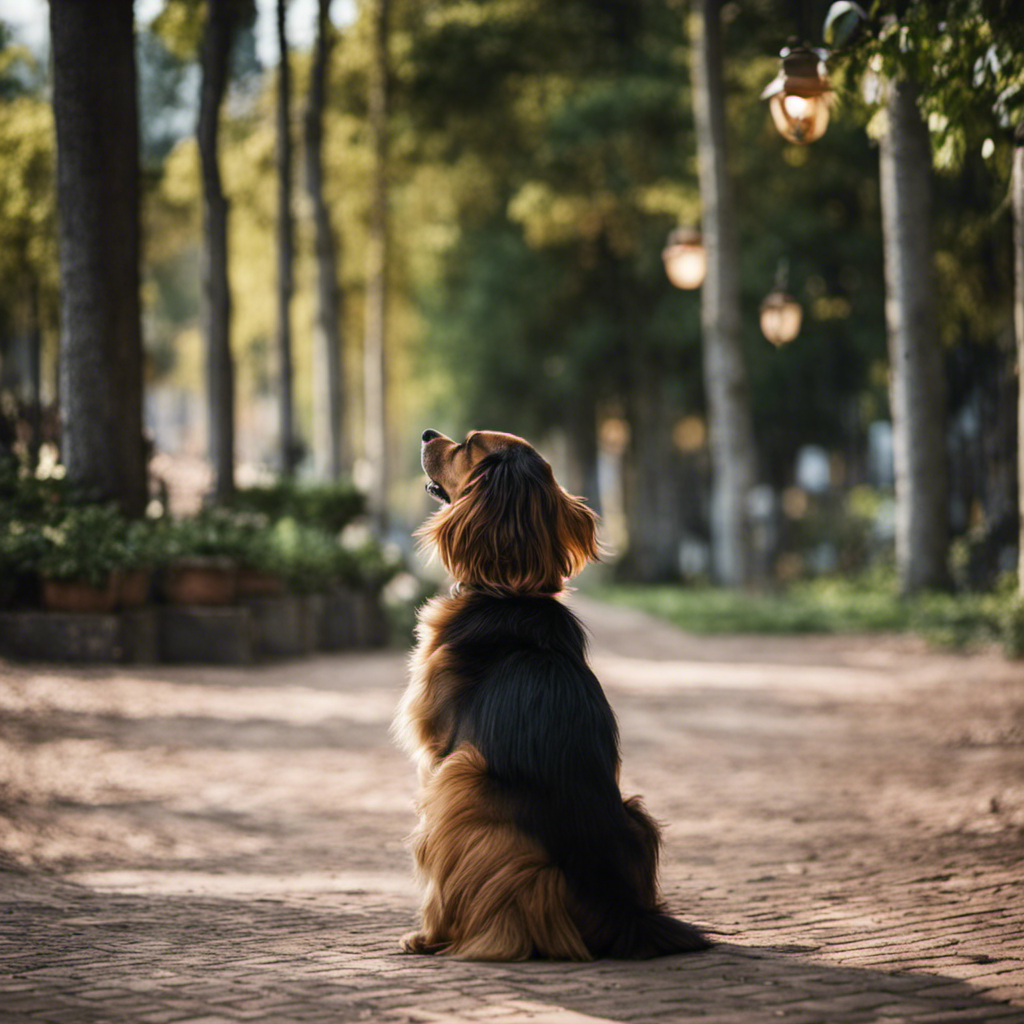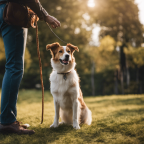- Key Takeaways
- Why Teach Your Dog the 'Gira' Command
- Benefits of Teaching Your Dog to Turn on Command
- Step-by-Step Guide to Teaching 'Gira' to Your Dog
- Common Challenges and How to Overcome Them When Teaching 'Gira
- Advanced Techniques to Enhance Your Dog's 'Gira' Command
- Practical Applications of the 'Gira' Command in Everyday Life
- Troubleshooting and FAQs for Teaching 'Gira' to Your Dog
Click and GO TO THE BEST DOG NAME GENERATOR HERE

Want to enhance your dog’s obedience training? Look no further than the ‘Gira’ command!
By teaching your furry friend to turn on command, you’ll not only impress your friends, but also improve your dog’s listening skills and overall behavior.
In this article, we’ll guide you through the step-by-step process of teaching ‘Gira’ to your dog, address common challenges, and even share advanced techniques to take your dog’s training to the next level.
Get ready to see your dog’s obedience soar with this essential Italian dog command.
- Key Takeaways
- Why Teach Your Dog the 'Gira' Command
- Benefits of Teaching Your Dog to Turn on Command
- Step-by-Step Guide to Teaching 'Gira' to Your Dog
- Common Challenges and How to Overcome Them When Teaching 'Gira
- Advanced Techniques to Enhance Your Dog's 'Gira' Command
- Practical Applications of the 'Gira' Command in Everyday Life
- Troubleshooting and FAQs for Teaching 'Gira' to Your Dog
Key Takeaways
- Teaching your dog the ‘Gira’ command enhances obedience and responsiveness.
- The ‘Gira’ command improves mental stimulation and physical coordination.
- Using ‘Gira’ helps guide your dog’s movements during walks.
- Teaching ‘Gira’ establishes a strong bond between you and your dog and provides a foundation for further training.
Why Teach Your Dog the ‘Gira’ Command
Why don’t you teach your dog the ‘gira’ command today? It’s a useful command that can help you communicate better with your furry friend. ‘Gira’ means ‘turn’ in Italian, and once your dog learns this command, you can use it to direct their movement and control their position. Pronouncing ‘gira’ is quite simple. Just say ‘jee-rah’ with a soft ‘g’ sound.
To teach your dog the ‘gira’ command, you can use various training tools. One effective method is using treats as incentives. Start by holding a treat in front of your dog’s nose and slowly move it to the side, saying ‘gira’ at the same time. When your dog turns their head to follow the treat, reward them with the treat and praise. Repeat this process until your dog starts to associate the command with the action of turning.
By teaching your dog the ‘gira’ command, you’ll enjoy multiple benefits. It enhances their obedience and responsiveness, making it easier for you to guide their movements. This command can be particularly helpful during walks or when you need your dog to change direction quickly. Additionally, it provides mental stimulation for your dog, as they learn to follow cues and respond to commands.
Benefits of Teaching Your Dog to Turn on Command
You can easily see the benefits of teaching your dog to turn on command when they become more obedient and responsive to your directions. Teaching your furry friend to turn on command not only improves their overall obedience, but it also enhances their mental stimulation and physical coordination.
Pronunciation tips are crucial to ensure effective communication between you and your dog. When giving the command ‘turn’ or ‘gira’ in Italian, make sure to pronounce it clearly and consistently. Use a firm and assertive tone to convey your expectations.
By teaching your dog to turn on command, you’re empowering them with a valuable skill that can be applied in various situations. For instance, during walks, you can guide your dog to change direction whenever needed, ensuring their safety and preventing potential accidents.
Moreover, teaching multiple commands, such as sit, stay, and turn, helps to establish a strong bond between you and your dog, as well as promoting their mental agility. These commands create a solid foundation for further training and allow you to effectively manage your dog’s behavior in different environments.
Step-by-Step Guide to Teaching ‘Gira’ to Your Dog
To teach your dog ‘Gira’, start by using treats and a clicker to reward them for following the step-by-step guide provided.
‘Gira’ is an Italian command that means ‘turn’. Pronunciation difficulties may arise when teaching your dog this command, as the ‘g’ sound in ‘Gira’ is pronounced as a soft ‘j’ sound, similar to the ‘g’ in ‘giraffe’. When starting the training process, it’s important to use clear and consistent pronunciation to help your dog understand what’s expected of them.
Reinforcement techniques such as positive reinforcement and repetition can be highly effective when teaching ‘Gira’. Begin by standing in front of your dog and commanding them to ‘Gira’ while gently guiding them in a clockwise or counterclockwise direction. As soon as they start turning, use the clicker to mark the behavior and immediately reward them with a treat. Repeat this process several times, gradually fading out the physical guidance and relying solely on the verbal command.
Remember to be patient and consistent during the training process. Now, let’s explore some common challenges and how to overcome them when teaching ‘Gira’.
Common Challenges and How to Overcome Them When Teaching ‘Gira
When teaching your dog the command ‘Gira’ (turn), you may encounter some common challenges.
One challenge is the pronunciation difficulties of this Italian command. To overcome this, practice saying ‘Gira’ clearly and consistently, and use hand signals to reinforce the meaning.
Another challenge is maintaining consistent reinforcement techniques. To overcome this, use positive reinforcement such as treats or praise whenever your dog successfully turns in response to the command ‘Gira.’
Pronunciation Difficulties
Can you pronounce ‘Gira’ correctly after practicing for a few minutes? Pronunciation can be tricky, especially when it comes to foreign words. But fear not, here are some pronunciation tips to help you master the command ‘Gira’ in no time:
- Start by pronouncing the ‘G’ sound as in the word ‘go’.
- Next, pronounce the ‘i’ sound as in the word ‘see’.
- Finally, pronounce the ‘ra’ sound as in the word ‘raw’.
With these tips in mind, you’ll be able to confidently pronounce ‘Gira’ like a native Italian speaker. Remember, practice makes perfect!
In addition to pronunciation, it’s worth noting that there are alternative commands that can be used to achieve the same result as ‘Gira’. These alternative commands include ‘ruota’, meaning ‘rotate’, and ‘voltati’, meaning ‘turn around’.
Reinforcement Techniques
You should consistently use positive reinforcement techniques when teaching ‘Gira’ to ensure a successful learning experience. Positive reinforcement involves rewarding your dog for performing the desired behavior, which encourages them to repeat it. This approach is proven to be more effective than punishment or negative reinforcement methods. By using rewards such as treats, praise, or play, you can motivate your dog to turn on command. To make the training process easier, you can create a table to track your progress. Here is an example:
| Command | Action | Reward |
|---|---|---|
| Gira | Turn | Treat |
Remember to be consistent, patient, and use clear cues when training. With these reinforcement techniques, your dog will quickly learn the ‘Gira’ command. Now, let’s explore some advanced techniques to enhance your dog’s ‘gira’ command.
Advanced Techniques to Enhance Your Dog’s ‘Gira’ Command
To enhance your dog’s ‘Gira’ command, try using the advanced technique of incorporating hand signals along with verbal cues. This method can help improve your dog’s understanding and response to the command.
Here are some tips to effectively use hand signals for ‘Gira’:
- Start by teaching your dog the verbal cue for ‘Gira’ and ensure they have a solid understanding of it.
- Introduce the hand signal by associating it with the verbal cue. For example, you can use an open palm facing upwards to signal ‘Gira’.
- Practice the verbal cue and hand signal together, gradually fading out the verbal cue and relying solely on the hand signal.
- Be consistent with your hand signal, using the same gesture every time you give the command.
- Use clear and deliberate movements to make the hand signal easily distinguishable for your dog.
- Reinforce the hand signal with positive reinforcement, such as treats or praise, to encourage your dog to respond correctly.
Practical Applications of the ‘Gira’ Command in Everyday Life
Incorporate the ‘Gira’ command into your daily routine, whether it’s guiding your dog around obstacles or navigating through crowded places. Pronounced as ‘jee-rah,’ this Italian command can be a valuable tool in enhancing your dog’s obedience and agility skills. By incorporating ‘gira’ into agility training, you can teach your dog to turn in different directions, improving their ability to maneuver through obstacle courses with ease.
To effectively use ‘gira’ in everyday life, start by practicing in low-distraction environments. Begin by saying the command while gently guiding your dog’s head in the desired direction. With consistent practice and positive reinforcement, your dog will soon understand the association between the command and the action. As you progress, gradually introduce more distractions, such as toys or other dogs, to ensure that your dog can perform the ‘gira’ command reliably in any situation.
By incorporating ‘gira’ into your daily routine, you can also use this command to navigate through crowded places. Whether you’re walking through a busy street or attending a public event, teaching your dog to ‘gira’ can help you maneuver through tight spaces without any hassle. Remember to always reward your dog for correctly following the command, as positive reinforcement is key in maintaining their motivation and focus.
Now that you have a solid understanding of incorporating ‘gira’ into your daily routine, let’s move on to troubleshooting and FAQs for teaching this command to your dog.
Troubleshooting and FAQs for Teaching ‘Gira’ to Your Dog
If your dog is still struggling with the ‘gira’ command, consistently practice in low-distraction environments to reinforce the association between the command and the action. Troubleshooting techniques can help address any issues that may arise during the training process.
Here are some tips to troubleshoot and FAQs for teaching ‘gira’ to your dog:
Vary your reinforcement methods:
- Use treats: Reward your dog with a small, tasty treat each time they successfully perform the ‘gira’ command.
- Verbal praise: Combine treats with verbal praise, such as saying ‘Good job!’ or ‘Well done!’ to reinforce the desired behavior.
- Physical touch: Some dogs respond well to physical touch, such as a gentle pat on the head or a scratch behind the ears, as a form of reinforcement.
Break it down:
- If your dog is struggling with the full ‘gira’ command, break it down into smaller steps. Start by teaching them to turn their head, then progress to turning their body in a circle.
- Gradually increase the difficulty by adding distractions or asking for faster and more precise turns.
Be patient and consistent:
- Training takes time and patience. Consistently practice the ‘gira’ command in short sessions, multiple times a day.
- Use the same command word and hand signal consistently to reinforce the association between the command and the action.
- Key Takeaways
- Why Teach Your Dog the 'Gira' Command
- Benefits of Teaching Your Dog to Turn on Command
- Step-by-Step Guide to Teaching 'Gira' to Your Dog
- Common Challenges and How to Overcome Them When Teaching 'Gira
- Advanced Techniques to Enhance Your Dog's 'Gira' Command
- Practical Applications of the 'Gira' Command in Everyday Life
- Troubleshooting and FAQs for Teaching 'Gira' to Your Dog


